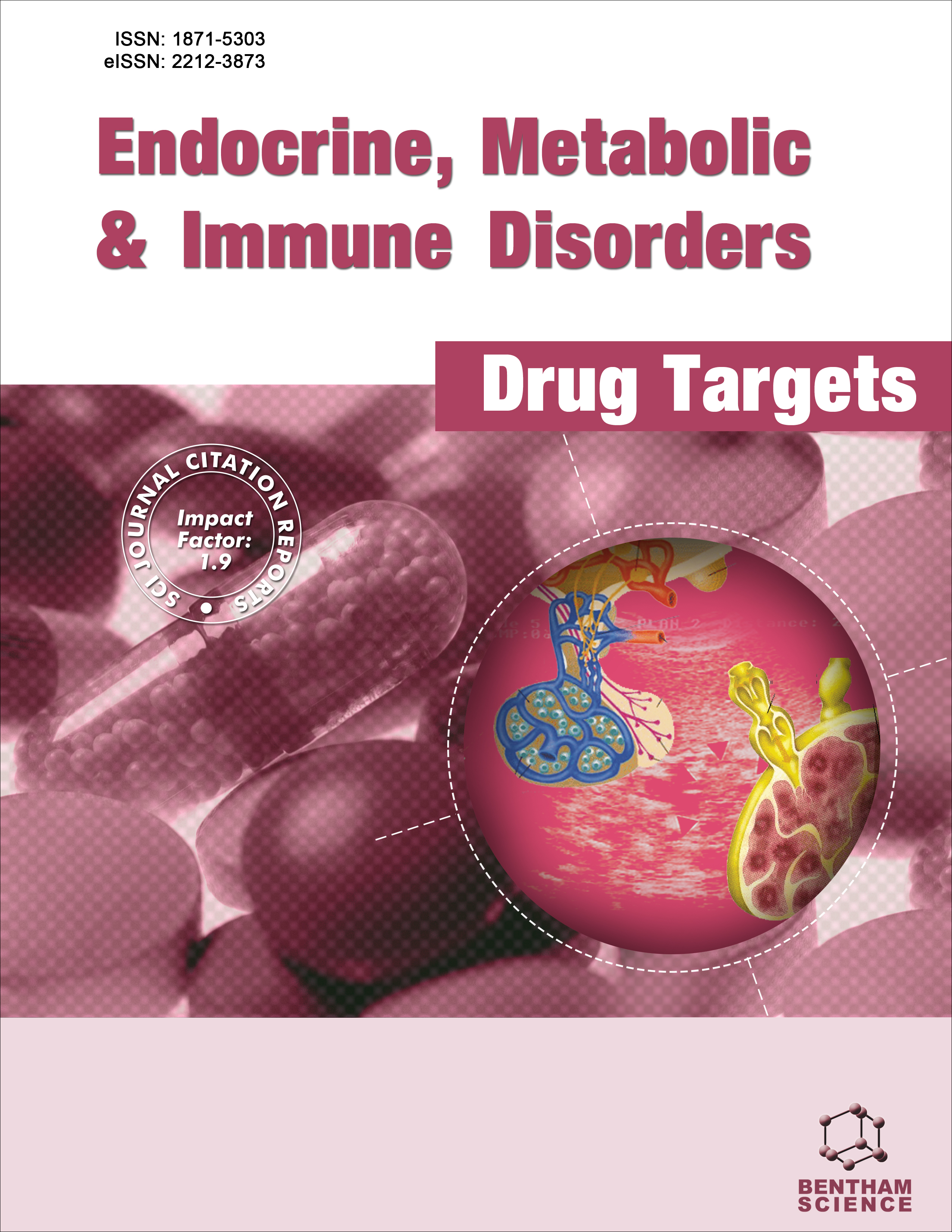- Home
- A-Z Publications
- Endocrine, Metabolic & Immune Disorders-Drug Targets (Formerly Current Drug Targets - Immune, Endocrine & Metabolic Disorders)
- Previous Issues
- Volume 24, Issue 3, 2024
Endocrine, Metabolic & Immune Disorders-Drug Targets (Formerly Current Drug Targets - Immune, Endocrine & Metabolic Disorders) - Volume 24, Issue 3, 2024
Volume 24, Issue 3, 2024
-
-
A Mini-review on Helicobacter pylori with Gastric Cancer and Available Treatments
More LessAuthors: Teresa V. Jacob and Gaurav M. DoshiHelicobacter pylori (H. pylori) is the most thoroughly researched etiological component for stomach inflammation and malignancies. Even though there are conventional recommendations and treatment regimens for eradicating H. pylori, failure rates continue to climb. Antibiotic resistance contributes significantly to misdiagnoses, false positive results, and clinical failures, all of which raise the chance of infection recurrence. Read More
-
-
-
A Review of Proposed Mechanisms in Rheumatoid Arthritis and Therapeutic Strategies for the Disease
More LessAuthors: Rupali Mohite and Gaurav DoshiRheumatoid arthritis (RA) is characterized by synovial edema, inflammation, bone and cartilage loss, and joint degradation. Patients experience swelling, stiffness, pain, limited joint movement, and decreased mobility as the condition worsens. RA treatment regimens often come with various side effects, including an increased risk of developing cancer and organ failure, potentially leading to mortality. However, researchers ha Read More
-
-
-
Mentha Pulegium: A Plant with Several Medicinal Properties
More LessAuthors: Smail Amtaghri, Miloudia Slaoui and Mohamed EddouksThe species Mentha Pulegium L. (M. pulegium L.) belongs to the family Lamiaceae, native to Europe, North Africa, and the Middle East, and the genus Mentha. It has been traditionally used in food, cosmetics, and medicines. It is a perennial, fragrant, well-liked, herbaceous plant that can grow up to half a meter tall. It is extensively used as a food flavoring, particularly for Moroccan traditional drinks. Chewing mint and M. p Read More
-
-
-
Chronic Stress as a Risk Factor for Type 2 Diabetes: Endocrine, Metabolic, and Immune Implications
More LessBackground: Chronic stress is a condition of pressure on the brain and whole body, which in the long term may lead to a frank disease status, even including type 2 diabetes (T2D). Stress activates the hypothalamus-pituitary-adrenal axis with release of glucocorticoids (GCs) and catecholamines, as well as activation of the inflammatory pathway of the immune system, which alters glucose and lipid metabolism, ultimately leading t Read More
-
-
-
miRNAs Delivery for Cancer-associated Fibroblasts' Activation and Drug Resistance in Cancer Microenvironment
More LessCancer-associated fibroblasts (CAFs) as a major component of cancer stroma contribute to diverse procedures of most solid tumors and might be a targeted cancer therapy approach. Their specified features, related signaling pathways, distinct biomarkers, and sub-populations need to be deciphered. There is a need for CAF extraction or induction for in vitro investigations. Some miRNAs could activate CAF-like phenotype a Read More
-
-
-
Investigation of Pancreatic-beta Cells Role in the Biological Process of Ageing
More LessAuthors: Rishabh Chaudhary, Janvi Khanna, Manni Rohilla, Sumeet Gupta and Seema BansalBackground: Cellular senescence is associated with the formation and progression of a range of illnesses, including ageing and metabolic disorders such as diabetes mellitus and pancreatic beta cell dysfunction. Ageing and reduced glucose tolerance are interconnected. Often, Diabetes is becoming more common, which is concerning since it raises the risk of a variety of age-dependent disorders such as cardiovascular dis Read More
-
-
-
The Mechanism of Plantaginis Semen in the Treatment of Diabetic Nephropathy based on Network Pharmacology and Molecular Docking Technology
More LessAuthors: Linlin He, Kai Shen, Lei He, Yuqing Chen and Zhiyuan TangBackground: Diabetic nephropathy (DN) is one of the common complications of diabetes. Plantaginis Semen (PS) has a variety of therapeutic effects, however its mechanism on DN is unclear. Objective: This paper aims to find the ingredients, the key targets, and the action pathways of PS on DN from the perspective of network pharmacology. Methods: The databases of network pharmacology, such as Traditional Chinese M Read More
-
Volumes & issues
-
Volume 25 (2025)
-
Volume 24 (2024)
-
Volume 23 (2023)
-
Volume 22 (2022)
-
Volume 21 (2021)
-
Volume 20 (2020)
-
Volume 19 (2019)
-
Volume 18 (2018)
-
Volume 17 (2017)
-
Volume 16 (2016)
-
Volume 15 (2015)
-
Volume 14 (2014)
-
Volume 13 (2013)
-
Volume 12 (2012)
-
Volume 11 (2011)
-
Volume 10 (2010)
-
Volume 9 (2009)
-
Volume 8 (2008)
-
Volume 7 (2007)
-
Volume 6 (2006)
Most Read This Month
Article
content/journals/emiddt
Journal
10
5
false
en


